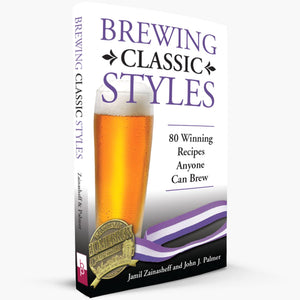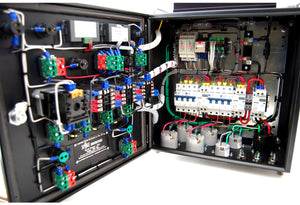Schwarzbier

Testimonials
"I brewed this a while ago and it's been aging and carbing in a keg for a few weeks. I tried a sample this evening and it turned out great! Thanks!" - Rockn M
"It's been aging for 3 months now and it's damn good. When it was young, it tasted like a very clean stout or porter. Now, it's mellowed out. The german flavor has come through. Still has a very slight roasted taste, but very clean, crisp, and remarkably light tasting for the black color. I'll be making it again or try the other version listed." - Fal
"... turned out excellent and by far my best Schwarz yet!" - Trout
Introduction
Schwarzbier (German for "black beer") is a dark lager that has its origins in the middle ages. Unlike most dark beers that are usually described as "heavy", schwarzbier is lighter bodied and refreshing despite its dark appearance (nearly opaque in colour). You'll find flavour notes of coffee and chocolate, but nothing too overpowering to take away from the beer's drinkability. It is light enough to be enjoyed on the hottest summer days.
Schwarzbier is the oldest European beer for which hard scientific evidence exists. According to a November 2002 BYO article, a crock from 800 BC was discovered in a prehistoric burial site that contained blackened barley, the standard raw material of ancient Germanic brews. Because the beer made from such toasted loaves would also be dark, it can be reasonably asserted that the crock contains residues of an ancient ancestor of schwarzbier.
The roots of 'modern' schwarzbier lie in the Thuringia and Saxony federal states of Germany with the oldest known black beer in that region being Braunschweiger Mumme, brewed since 1390 in the city of in Braunschweig located in Lower Saxony. The earliest documented mention in Thuringia is from Köstritzer brewery that produced schwarzbier at least as early as 1543 and still produces it today. The present-day East Germany has many unique varieties of this style from regional breweries. The style has also expanded to breweries throughout the world with many in North America and elsewhere now producing award winning schwarzbier variations.
 Köstritzer Schwarzbier. Image (c) bitburger-international.com
Köstritzer Schwarzbier. Image (c) bitburger-international.com
The version of schwarzbier in this recipe is an award winner from our favourite brewing recipe book: Brewing Classic Styles. It sits on the edge of the style guidelines as it is a little too roasty when compared to most classic commercial varieties such as Köstritzer.
That said, this version has won more than 20 medals by professional and amateur brewers alike at both the AHA National Homebrew Competition and GABF, including Best of Show and at least one gold medal. This 'slightly too roasty' version is popular so don't be surprised if this is the sort of schwarzbier you receive when you order one at various breweries across North America.
If you prefer to make something a little less roasty, more along the lines of a classic Köstritzer, make the following changes to the recipe:
- Increase the Weyermann pilsner malt from 9.8 lb (51.2%) to 15 lb (84.3%)
- Decrease the Dark Munich malt (9L) from 7.4 lb (38.7%) to 1.65 lb (9.3%)
- Increase the Weyermann Carafa II Special malt (430L) from 5.5 oz (1.8%) to 18.25 oz (6.4%)
- Drop all other malts
- Lower the mash temperature from 154F to 151F for a slightly dryer beer
Whichever version you end up choosing, brew up a batch and let us know how you like it!
Schwarzbier
Size: 12 US gallons (post-boil @ 68F)
Mash Efficiency: 95%
Attenuation: 74.5%
Calories: 169 kcal per 12 fl oz
Original Gravity: 1.051 (style range: 1.046 - 1.052)
Final Gravity: 1.013 (style range: 1.010 - 1.016)
Colour: 22 SRM (style range: 17 - 30)
Alcohol: 5% ABV (style range: 4.4% - 5.2%)
Bitterness: 29 IBU (style range: 20 - 30)
Mash:
9.8 lb German pilsner malt (1.5-2.1L) (51.2%)
7.4 lb Dark Munich malt (9L) (38.7%)
10 oz Crystal malt (40L) (3.3%)
10 oz Chocolate malt (350-500L) (3.3%)
5.5 oz Roasted barley (500L) (1.8%)
5.5 oz Weyermann Carafa II Special malt (430L) (1.8%)
Boil:
3.5 oz German Hallertau hops (4.5%) - added during boil, boiled 60 min [24.6 IBU]
1 oz German Hallertau hops (4.5%) - added during boil, boiled 20 min [3.9 IBU]
1 Whirlfloc tablet (Irish moss) - added during boil, boiled 15 min
1 oz German Hallertau hops (4.5%) - added during boil, boiled 1 min [0.3 IBU]
Post-boil:
1 oz German Hallertau hops (4.5%) - added immediately after boil
Yeast:
Fermentis Saflager W-34/70 dry yeast* (72g recommended or make an equivalent starter)
*If you prefer to use liquid yeast, Wyeast 2124 Bohemian Lager or White Labs WLP830 German Lager are said to be the equivalent Weihenstephan sourced strains. You'll need ~860 billion cells (8-9 fresh packs) or an equivalent starter.
Purchasing through our affiliate links helps support our site at no extra cost to you. We thank you!
Notes / Process
- Add 500mg potassium metabisulfite to 20 gallons water to remove chlorine / chloramine (if required).
- Water treated with brewing salts to our Balanced flavour profile: Ca=50, Mg=10, Na=16, Cl=70, SO4=70. (Hit minimums on Ca and Mg, keep the Cl:SO4 ratio low and equal. Do not favour flavour / maltiness or bitterness / dryness. For balanced beers.). For more information on how to adjust your water, refer to our step by step Water Adjustment guide.
- 1.25 qt/lb mash thickness.
- Single infusion mash at 154F for 90 mins.
- Raise to 168F mashout temperature and hold for 10 mins.
- ~90 min fly sparge with ~5.6-5.8 pH water (measured at mash temperature).
- Boil for 90 minutes, adding Whirlfloc and hops per schedule. Lid on at flameout, start chilling immediately.
- Cool the wort quickly to 50F (we use a one-pass convoluted counterflow chiller to quickly lock in hop flavour and aroma) and transfer to fermenter.
- Aerate or oxygenate the chilled wort to a level of 8-10 ppm dissolved oxygen. For more information refer to our Aerating / Oxygenating Wort guide.
- Pitch yeast and ferment at 50F (wort temperature). We use modified stainless fermenting buckets in wine fridges.
- Ferment until approximately 5 points from final gravity and then raise the temperature to 70-72F until finished. In our case we simply turn off the fermenting fridges and allow the beer to naturally rise to room temperature. Assume fermentation is done if the gravity does not change over ~3 days.
- Before packaging you may optionally rack to a brite tank (we use 5 gallon glass carboys) that has been purged with CO2 to avoid oxygen pickup, add 1 tsp of unflavoured gelatin dissolved in a cup of hot distilled water per 5 gallons of beer, and allow to clear for 2-3 days. In most cases we recommend skipping this step as the less you handle the beer and potentially expose it to oxygen, the better. The beer will drop brilliantly clear on its own during the conditioning period.
- Package as you would normally. We rack to kegs that have first been purged with CO2 and then chill to near freezing while carbonating at the same time in a 6-keg conditioning fridge. After ~1-2 weeks at serving pressure the kegs will be carbonated and ready to serve. In a hurry? Feel free to raise the CO2 pressure temporarily to 30-40 PSI to carbonate fast over a 24 period, and then turn back down to serving pressure.
- Carbonate this beer to around 2.5 volumes of CO2.
- For an interesting twist on the style, serve the beer on a stout faucet pushed by a nitrogen/CO2 blend, producing a nice creamy head and close to flat beer. One inexpensive way to mimic this is to use a syringe (without needle). Pour the beer as you would normally and then suck up a syringe full and force it back into the beer, hard. Repeat 2-3 times and you'll knock most of the CO2 out of solution leaving a nearly flat beer with a creamy head. Not quite the same texture, but similar to a nitro pour. We tried this for years before finally adding a real nitrogen/CO2 serving setup to our basement bar.
- This beer will improve greatly if conditioned just above freezing for at least 4 weeks before serving (6-8 weeks is better). Avoid keeping the beer unrefrigerated for extended periods. It will remain clean and crisp for months if kept near freezing.
For detailed brewing instructions, see our Brew Day Step by Step guide.
Enjoy!
Questions? Visit our Schwarzbier forum thread.
Pictures / Videos
Interested in seeing what we're brewing right now? Follow us on Instagram for pictures and videos of our brewing activities as they happen.
 Cedar Springs Brewing Company's Küsterer Schwarzbier. Image (c) csbrew.com
Cedar Springs Brewing Company's Küsterer Schwarzbier. Image (c) csbrew.com






